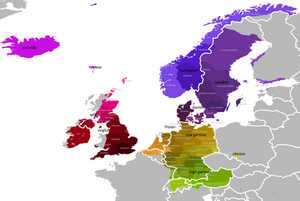Pan-Germanic language facts for kids
A pan-Germanic language is a special kind of made-up language. It's designed to help people who speak different Germanic languages talk to each other. Think of it like a common language for a family of languages! While many of these languages are quite similar, their spellings, sounds, and words don't always match up perfectly.
Contents
Why Create These Languages?
The main idea behind a zonal auxiliary language is to create a way for people who speak related languages to communicate easily. The Germanic language family includes many different dialects and languages. The most widely spoken ones are English, German, Dutch, Swedish, Danish, and Norwegian. These are usually the main focus when creating a pan-Germanic language.
Some of these special languages even focus on smaller groups. For example, some might try to unite just the North Germanic languages (like Swedish and Norwegian) or just the West Germanic languages (like English and German).
Creating these languages is a bit like building a puzzle. To make a new word or a grammar rule, people look at all the Germanic languages. They then pick the form that is most common or makes the most sense across many of them. They also look at other similar made-up languages to get ideas.
Early Attempts: Tutonish
The first clear effort to create a language for all Germanic speakers was called Tutonish. It was developed by a person named Elias Molee in 1901. He later updated it in 1906 and 1915. Tutonish was very simple. Its spelling system was easy to learn but didn't look like any natural Germanic language. Even with its simple style, Molee set up some important ideas that helped future language creators.
Other Projects You Should Know About
Later in the 20th and 21st centuries, other projects were started. None of them have become widely used, but they are interesting attempts:
- Euronord was created by a language expert named Adrian J. Pilgrim in 1965. He was also an expert in the Manx language. Euronord was mainly based on English, Dutch, German, Norwegian, Danish, and Swedish. It was meant to be a common language for people in Northern Europe. Not much is known about Euronord today.
- In 2000, a new project appeared online by Aaron Chapman. It was first called Folksstem, then later Nordien and Nordienisk.
- Folkspraak is a group project that started online in 1995. It's a collaborative effort, meaning many people work on it together. However, it hasn't moved forward much. Different ideas within the Folkspraak community have led to several versions. These include Middelsprake (created by Ingmar Roerdinkholder in 2004), Sprak (by Stephan Schneider in 2006), and Frenkisch (by David Parke in 2008).
- Tcathan or Chathan started being made in 2007. This language takes ideas from Dutch, Afrikaans, German, North Germanic languages, Modern English, Old English, and even Proto-Germanic (a very old form of Germanic).
See also
 In Spanish: Middelsprake para niños
In Spanish: Middelsprake para niños
- Interlingua
- Pan-Germanism
- Scandinavism


